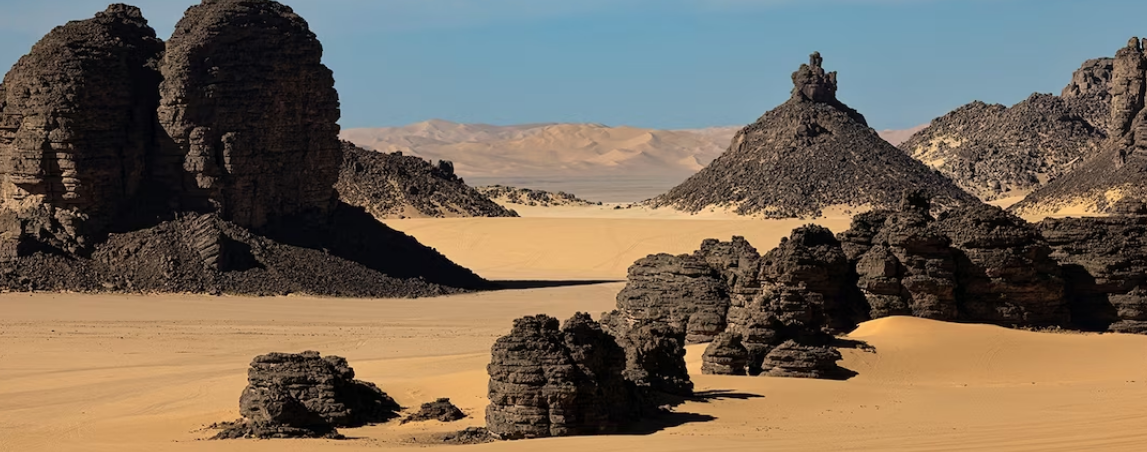nationalgeographic.com
Few people will have heard of Tassili N’Ajjer National Park, even though it is the largest national park in Africa—a testament to its anonymity and remoteness.
Located in the southeast corner of Algeria
The region is a geological wonderland of uncanny rock formations lapped by orange dunes. Eons of erosion have sharpened the sandstone into pinnacles, worn apertures through high escarpments, and sculpted outcrops into surreal and zoomorphic forms. The park is thought to contain over 300 natural arches alone.
But these rock forests are only half the story. Tassili’s majesty lies not just in the visual splendor of the rocks, but also what past generations have left on them.
A museum of prehistoric rock art
Among Tassili’s most beautiful areas is Tadrart Rouge, accessible via 4×4 tours from the oasis town of Djanet, a two-and-a-half-hour flight from the Algerian capital, Algiers.
As the guides who run the tours—invariably members of the nomadic Tuareg tribe—identify places to pull over, visitors will often see ancient etchings and paintings decorating the rock.
(See the ancient Roman city buried in the Algerian Sahara for centuries
The French archaeologist Henri Lhote, who documented many of Tassili’s 15,000 pieces of rock art in the 1950s and was later denounced for his vandalistic working practices, vaunted the region as “the greatest museum of prehistoric art in the whole world.”
These alfresco galleries are an eloquent ethnological record of the peoples who were drawn here through the ages. Curiously, many of the most prominent and accomplished petroglyphs depict large mammals more commonly associated with sub-Saharan Africa, including elephants, giraffes, rhinos, and hippopotami.
When the Sahara was green
The epic subtext to this natural and human-made artistry is the “greening” of the Sahara. The scale of the erosion, especially in the deep-carved ravine systems to the north, indicate that Tassili’s parched wilderness was once crisscrossed by waterways.
Paleoclimatologists have speculated that, between 11.7 to 5.5 thousand years ago, changes to the tilt and orbit of the earth in relation to the sun warmed the northern hemisphere.
During this “African Humid Period,” longer and more intense summer monsoons filled geological basins with lakes and wetlands. Great rivers connected the Atlantic to the Mediterranean shoreline of the Maghreb. Large mammals roamed the endless grasslands.
The art of change
The rock art in Tassili N’Ajjer tracks the climatic shifts that were to follow. As the region’s weather patterns evolved, so did its human society. Several overhangs feature detailed, naturalistic pictures of piebald (irregularly colored) cattle, recalling the transition from hunter-gathering to mobile pastoralism. Many of the surviving images from this “bovidian” era are drawn in carmine paint, derived from crushed stone mixed with cow’s blood.
One exception is among the region’s most famous artworks. On a lone outcrop, near the road that today runs between Djanet and the Libyan border, is an etching known as the “Crying Cows.” Carved by a master craftsman, it shows a group of cattle in sweeping, calligraphic lines.
The heads of the cows are turned toward the viewer, and each one has a large tear welling beneath one of its eyes. Local legend has it that the herd represents the herders’ anxiety as the rains dried up, and the Sahelian vegetation that had sustained large mammals for several millennia receded.
The weeping cows are a presentiment of the Sahara’s arid present. As an age of fecundity was succeeded by an age of dust, the elegant glyphs gave way to diagrammatic scrawls of camels—the hurried, “I was here” graffiti of people living on the move.
In recent decades, local instability, most notably civil conflicts in Libya and Niger, has prohibited access to much of the national park. The sheer size of wilderness places it beyond the reach of Algerian military patrols.
Although Tadrart Rouge alone feels like a world unto itself, much of Tassili’s rock art, and the astonishing landscapes that form their backcloth, remain lost to time.
WHAT TO KNOW
Teams consist of a guide, driver, and cook, and come equipped with camping gear, food, and water. A seven-day tour with Fancy Yellow, including domestic flights, costs around $770 per person.
Visitors with more time might want to combine a trip to Tassili with a trip to the Algerian Sahara’s other great marvel: Hoggar National Park. This extraordinary mountain range of basaltic volcanic plugs is accessible from the town of Tamanrasset, which is a 45-minute flight west from Djanet.





